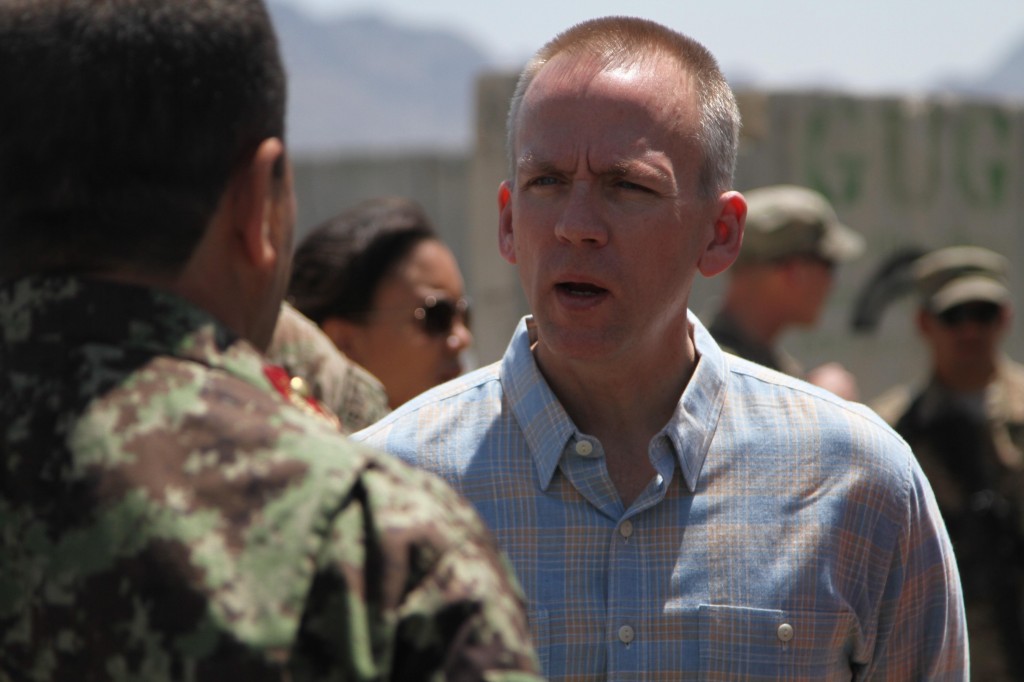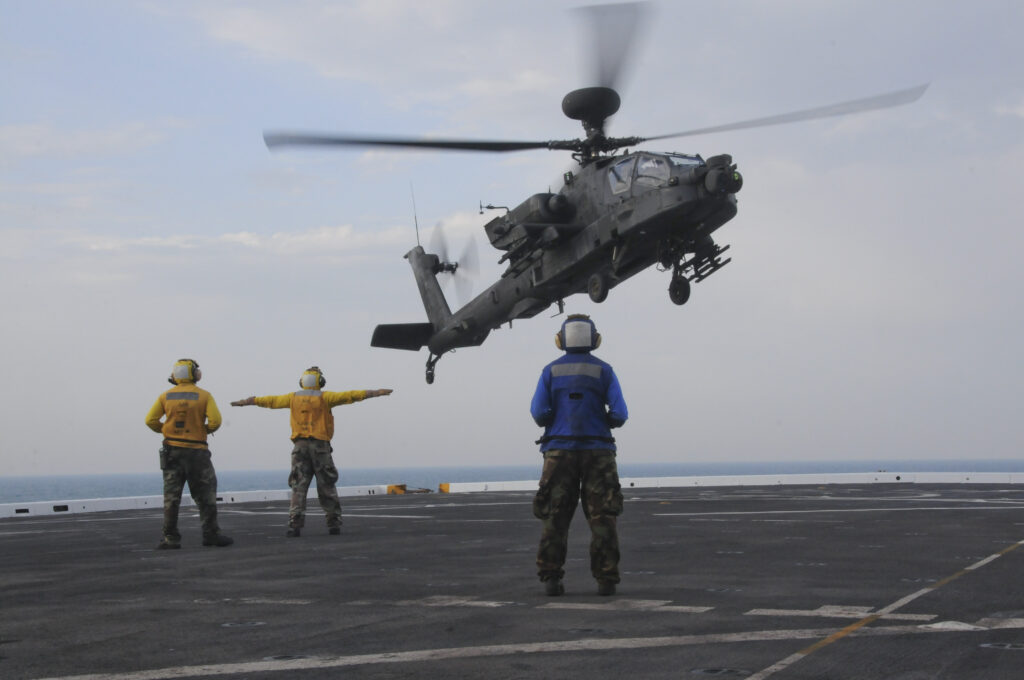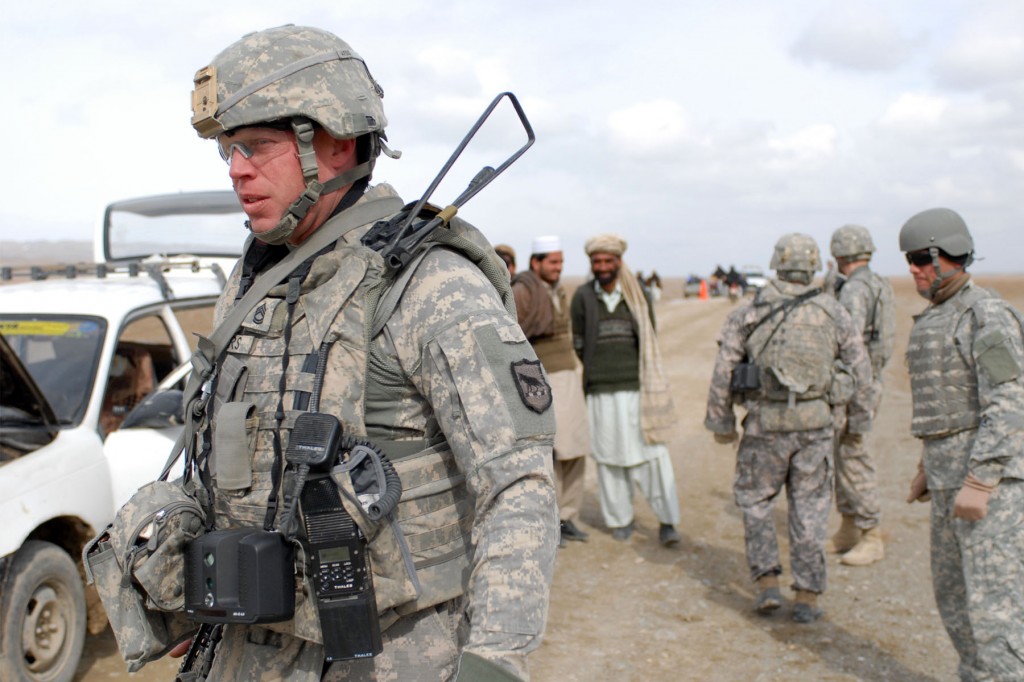Army Hates To Take Guard Apaches, But It ‘Must Happen’: UnderSec Carson
Posted on

Brad Carson, Under Secretary of the Army, talks to solders in Afghanistan.
WASHINGTON: This hurts us more than it hurts you. That’s the essence of the regular Army’s message to the National Guard about the Aviation Restructure Initiative (ARI), a controversial cost-cutting plan that — among other things – strips the Guard of all its AH-64 Apache attack helicopters. Pain is on its way for all of us, leader after leader told me, and ARI is the least worst way to allocate it. But can they convince a skeptical Congress?
“I think ARI will happen. I think indeed it must happen,” Army Under Secretary Brad Carson told me in an exclusive interview. (We’ll have more from this wide-ranging interview later). Just the day before, he had joined a delegation led by Defense Under Secretary Robert Work to meet with a committee of the Council of Governors. (Defense Sec. Hagel himself took time from a trip to Fort Rucker, the home of Army aviation, to dial in). “That’s one of the points I made yesterday: All of these cuts are not ones that the Army wanted,” said Carson. “One of the governors asked me where we stood on these issues, and I said, ‘we fight them. We don’t like the cuts, but Congress has visited these things upon the Army and upon the entire Department of Defense.’”
Counting the automatic spending cuts known as sequestration, Carson said, DoD will have to bear a trillion dollars in cuts by 2023, $400 billion of which falls on the Army. “Aviation modernization, aviation operations and sustainment, are extremely expensive,” Carson said, even at the best of times. Today, after 13 years of using existing helicopters hard while canceling or indefinitely delaying replacements like Comanche and the Armed Aerial Scout, “we have long deferred bills from periods of war,” he said, including “massive bills that are coming through in modernization for other aging aircraft that are going to crowd out Future Vertical Lift” — a proposed super-chopper for the 2030s — “not to mention harm readiness” in the nearer term.
Today, Army aviation readiness is “the highest we’ve ever seen since I’ve been in uniform,” said Gen. Dennis Via, the head of Army Materiel Command, at a breakfast with the Defense Writers’ Group this morning. “If we maintain all of those [current] platforms, we won’t be able to sustain the readiness rates we have today.”
So the Aviation Restructure Initiative would prune the current array of helicopters, retiring aging aircraft to avoid the costs of sustaining and modernizing them. Most dramatically, it eliminates the entire fleet of OH-58 Kiowa armed scout helicopters — active, Guard, and reserve — which if retained would require $10 billion for even a modest modernization. In fact, the reason the regulars are taking the Guard’s Apaches in the first place is to replace their Kiowas in the armed reconnaissance role.
“My hope is we can work with the governors constructively and the TAGs [the state Adjutants-General] and the states to have a resolution, to explain to them the dilemmas we face,” Carson told me. “I’m very hopeful…. I think in the end, people will recognize that these are not easy decisions, they are not even desirable ones from the Army’s perspective, but they are in the end the best decisions to balance the needs of the Department of Defense and the needs of the total force.”

The Fairness Debate: ‘Here’s What’s Painful’
But doesn’t losing all their combat helicopters — both Apaches and Kiowas — make the Army’s chosen solution disproportionately painful for the National Guard? That’s the question I had asked Brig. Gen. Michael Lundy, commander of the Army’s aviation center at Fort Rucker, just the day before I met with Under Sec. Carson.
“Here’s what’s painful,” Lundy said, interrupting. “If we want to talk about what’s painful, it’s painful for Army aviation [as a whole]. We’re losing ten thousand soldiers out of our branch.”
Yes, Lundy said, all the Guard’s AH-64 pilots and maintainers will have to retrain to operate other aircraft if they want to stay. But the same is true for everyone who works on OH-58D Kiowas, which are being retired from both active and reserve units. “I’m a 58D guy,” Lundy said. “That’s what I’ve flown all my life, so I can understand the emotion and passion, but emotion and passion mean very little when you look at what’s best for the nation.”
“Last week I notified nine captains, active-duty captains, that they had been selected…to leave the service,” Lundy said, visibly struggling with his own emotion and passion. “I can tell you all nine of them were great officers,” he added: After 13 years of war, with helicopters in high demand, the deadwood is long gone.
“Throughout all three compos” – i.e. the active, Guard, and reserve components of the aviation branch – “there are going to be some great people that are going to be handed their walking papers,” Lundy said. “That’s emotional, that certainly is.”
With three active-component aviation brigades disbanding, Lundy added, “The majority of the downsizing is coming out of the active component; about 23 percent of active Army aviation is going away, [compared to] only eight percent of the Guard. So the active component is taking a disproportionate cut, significantly disproportionate.”
Guard advocates have heard those figures before, however, and they’re distinctly unconvinced. Proportionately is beside the point, they say: What matters in the time of budget cuts is cost-effectiveness, and by that criterion you should cut the Guard as little as possible.
“We’re doing this to save money and the Guard is cheaper,” said John Goheen, spokesman for the powerful National Guard Association of the United States. “It just makes sense that you would cut the Guard less. [Instead], the active component is really trying too hard to consolidate all the Apaches in the active force, which will actually cost the nation more money.”
Yes, the equipment itself costs the same whoever has it: about $20 million to upgrade an Apache to the latest AH-64E standard, $600-$700 million to kit out an entire Apache battalion. But Guard personnel are paid part-time to train part-time – albeit much more often than in the bad old “weekend warrior” days” – so once equipped a Guard unit costs much less to keep up than its active-duty component, until you actually mobilize it.
So if you want to keep the largest possible number of Apaches and pilots in service at the lowest possible cost, ready to darken the enemy’s skies in time of war, then putting them in the Guard is the way to go. But that’s not what the Army is trying to do.

A National Guard AH-64 Apache lands on a Navy ship — a rare skill in the Army. But the Pentagon’s budget plans would move all Guard Apaches to active-duty units.
The Deployability Debate: ‘A Tremendous Desire For More Apache Helicopters’
What drives the Army’s calculations is not the number of Apaches they might need to send to a major war: It’s the number of Apaches they need to keep deployed all the time.
“We have combatant commanders” — the military’s regional chiefs — “who have a tremendous desire for more Apache helicopters,” Carson told me. “What the combatant commanders tell us is they need a certain number of attack helicopters, they need them in certain configurations, they need them teamed with unmanned sensors [i.e. drones]. Trying to satisfy their demands, which is after all is our fundamental job here as a [US Code] Title X Army, is extremely difficult to do.”
“We have to get more deployable time out of the ones we’ve got,” Carson continued, “[so] we have to have those Apaches in the active component.”
“Certainly having combat power in the Guard is absolutely critical,” said Brig. Gen. Lundy. “If we had more brigades and more money and more time, would we do that? Absolutely. But we’ve got to go down to 20 [Apache] battalions and we’ve got a steady state requirement for 20 battalions just in the active component.”
After years of wartime buildup, the Army now has 35 battalion-sized units of armed helicopters, both attack battalions (Apaches) and cavalry squadrons (currently Kiowas). Under the planned cuts, “we’re only going to have twenty in the entire Army,” active, Guard, and Reserve combined, said Lundy. “Right now we’ve got nine committed, and that’s not just in combat in [Afghanistan].”
If that level of activity continues after the drawdown in Afghanistan — which Carson and Lundy think it will; witness the recent deployment of Apaches to Iraq — then it puts an ever-harder burden on a smaller force.
Nine units deployed out of 35 total is manageable: Each battalion can average almost four months at home for every month deployed. Naturally, Guard troops would get more “dwell time” between missions, because they have civilian jobs to go to, and regulars would get less, since they’re full-time soldiers. But nine deployed out of 20 is nearly 50:50: Each battalion would spend almost as much time deployed as it did at home. That’s painful enough for regulars, as the past decade has shown. For Guard units, it would be unbearable.
Under current Defense Department policies, said Lundy, a Guard unit can deploy only one-third as often as a regular one. By this math, it would take 60 Guard battalions to provide the same steady-state presence abroad as 20 active battalions. Of course, the Pentagon could simply change those policies. But there limits. If Guard soldiers spend as much time deployed as regulars do, they might as well not be in the Guard anymore: They’d effectively become active-duty troops with inferior pay and benefits — and some very unhappy civilian employers.
Similarly, though the Pentagon can fund more or fewer training days, if Guard troops spent as much time training as their active-duty counterparts, they’d have no time for their civilian jobs. Army leaders argue Guard training time was adequate for most missions in Afghanistan and Iraq, but not for the most tactically complex tasks involving many aircraft supporting a large ground operation, which they believe will be the norm in future wars.
Guard advocates, of course, aren’t buying the Army’s assumptions. Guard soldiers may train fewer days, but they’re also often older and more experienced than their active-duty counterparts, so arguably they need less time. Especially in the Guard Apache community, “the pilots have flown that aircraft for years and years,” Goheen said. “You’re talking about taking aircraft away from the most experienced pilots and maintainers in the total Army….You’re just squandering the expertise resident in the National Guard.”
Goheen is also skeptical that deployments won’t drop significantly after the drawdown in Afghanistan. “I think what’s in order is really more discussion about this demand” from the combatant commanders, he said. “We all read that some Apaches are going to be in reserve over in Iraq; that could’ve been a Guard unit.”
In the end, the question goes beyond calculations of training days, cost-effectiveness, and force size to something fundamental: What is the National Guard for?

South Dakota National Guard soldiers on duty in Afghanistan.
The Identity Debate: ‘The Bonds That Unite’
“These force structure changes in no way diminish the contributions of the National Guard,” Under Secretary Carson told me. “No one is disparaging that. [And] we have considered their input; in fact we have changed ARI as it was originally conceived to reflect the input that the TAGs [adjutant generals] and the NGB [National Guard Bureau] and the outside groups have weighed in with,” including the National Guard Association of the US itself.
The biggest changes, however, require Congress to approve funding above the Budget Control Act caps, a long shot, or carving up some other defense priority to help the Guard, which is politically more likely. The revised Aviation Restructure Initiative would buy 100 new LUH-72 Lakotas to replace geriatric TH-67 training helicopters at Fort Rucker — originally the Lakotas would have been taken from the Guard — and increase the Guard’s fleet of UH-60 Black Hawks by 111.
That’s a good trade for the Guard, Army leaders argue, because Black Hawks are multi-mission utility aircraft that can carry emergency supplies, relief workers, or evacuees in civilian disaster relief, while Apaches are purely war machines. “An AH-64 does absolutely nothing for a state,” said Lundy.
“Active component leadership says the Black Hawk is really better for domestic missions,” said Goheen. “Well, yeah, certainly that’s the case. But is the Army going to come around and say that about tanks, about Bradleys? This is where it starts; where does it end?”
The Army is not currently proposing to strip the Guard of ground combat units. Congress, for its part, consistently adds money to the budget request to buy the Guard additional heavy armored vehicles. But Goheen’s response reveals the deep anxiety in the Guard that the regular Army will relegate them to a supporting, non-combat role.
“We’re moving away from ‘Total Force,'” in which any major combat operation requires both regular and National Guard soldiers, Goheen said. “Total Force was a lesson learned from Vietnam,” when the Guard was never mobilized.
“There is a spirited discussion abut how best to structure the Total Force,” Carson told me. “I would never want to overstate the acrimony…. With a background in politics myself, I really see it as a spirited, good faith debate in which very difficult decisions are going to have to be reached, decisions not everyone will agree with. But in the end, I think no one doubts that the bonds that unite the components are far, far, far stronger than the forces that would tear them apart.”
Subscribe to our newsletter
Promotions, new products and sales. Directly to your inbox.
